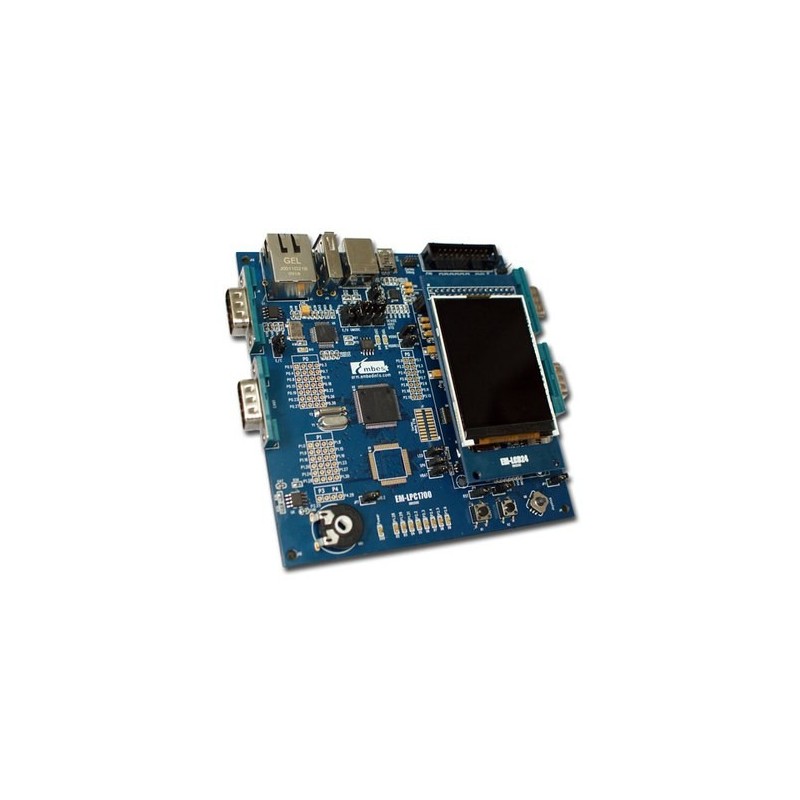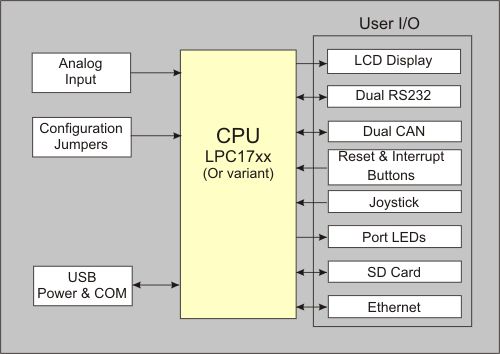- Obecnie brak na stanie

The LPC1768 evaluation board is based on ARM Cortex-M3 processor from NXP, its operating frequency is up to 100MHz, with 512KB high-speed on-Chip Flash Memory and 64KB RAM, together with a colour QVGA LCD, Ethernet, USB, CAN, SD/MMC card interface, and UARTs.
Overview
You can use the Cortex-M3 based LPC1768 ARM Evaluation Board to generate and test application programs for the NXP LPC17xx microcontroller family. The LPC1768 ARM Evaluation Board introduces the new NXP LPC1760 family of ARM Cortex-M3 processor-based devices, allowing you to create and test working programs for this advanced architecture, it has a wide range of interfaces making it a great starting point for your next Cortex-M3 project. With this hands-on process, you can determine the hardware and software requirements for current and future product development.
The LPC1768 ARM Evaluation Board ships with the LPC1768 device that is a superset of several other device variants of the LPC17xx microcontroller series. The LPC1768 Board contains all the hardware components required in a single-chip LPC17xx system.
Hardware Specifications:
The connectors on the LPC1768 arm evaluation board provide easy access to many of the LPC1768's on-chip peripherals.
Block Diagram:

Technical Data
| Parameter | Description |
| Supply Voltage | 5V DC (provided by the USB bus of a PC) |
| Supply Current | 65mA typical, 120mA maximum |
| XTAL Frequency | 12 MHz |
| Microcontroller | NXP LPC1768 |
| Peripherals | 2 × RS232 Interfaces 2 × CAN Interfaces 1 × Ethernet Interface 1 × JTAG Interface 1 × ETM Interface 2 × Cortex Debug Interfaces 1 × LCD Display 1 × USB Device/Host/OTG Interface 1 × Analog Output (connected to speaker by default) 1 × Analog Input (connected to potentiometer by default) |
| Board Size | 119mm x 119mm (4.68 " x 4.68") |
Software and Examples
Embest provides plenty of software examples for this evaluation board, all in source code. These software examples can be debugged under the popular Keil MDK (Microcontroller Development Kit) environments, making practical use of the board's peripherals.
Documentations
There are plenty documentation and material of Embest products, such as user’s manual, schematic of the board, development guideline and most of the major chips’ datasheet, convenient to find them in the accompanied CDROM.
PACKING LIST
| NO | NAME / TYPE | QTY | DESCRIPTION |
| 1 | Embest LPC1768 ARM-CM3 Board | 1 | Main board. |
| 2 | RS-232 Serial Cable / DB9 F-M | 1 | Connect the COM port to Host PC. 9-pin male to 9-pin female, no longer than 10ft/3m, wired one-to-one. |
| 3 | USB Cable / A-B | 1 | To supply power to the board or for downloading and programming. |
| 4 | RJ45 Ethernet Cable | 1 | Connect to the Ethernet port. |
| 5 | TFT LCD Panel | 1 | QVGA(240x320) |
Producent BTC Korporacja sp. z o. o. Lwowska 5 05-120 Legionowo Polska sprzedaz@kamami.pl 22 767 36 20
Osoba odpowiedzialna BTC Korporacja sp. z o. o. Lwowska 5 05-120 Legionowo Polska sprzedaz@kamami.pl 22 767 36 20
8-bitowy dwukierunkowy konwerter poziomów napięć z układem ST2378 firmy STMicroelectronics, 13 Mb/s, 1,8-5,5 V
Moduł z cyfrowym czujnikiem temperatury i termostatem z interfejsem I2C
Moduł programowalnego sterownika LED RGB i RGBA
Moduł KAmodLED8 umożliwia monitorowanie stanów 8 linii cyfrowych za pomocą LED sterowanych poprzez bufory cyfrowe.
Wersja mini programatora-debuggera Segger J-Link EDU (8.08.90). Umożliwia obsługę JTAG/SWD w mikroprocesorach z rdzeniami Cortex-M. Wersja tylko do użytku niekomercyjnego. J-Link EDU mini
Moduł RTC DS3231 dla Raspberry Pi to precyzyjny zegar czasu rzeczywistego, zasilany bateryjnie i komunikujący się przez interfejs I2C, który zapewnia dokładność pomiaru czasu dzięki kompensacji temperaturowej i rezonatorowi kwarcowemu
Brak towaru
Cyfrowy efekt ECHO do zastosowania w systemach audio. MK182
Brak towaru
INTERFEJS WYŚWIETLACZY GRAFICZNYCH LCD - PŁYTKA DRUKOWANA I ZAPROGRAMOWANY UKŁAD
Brak towaru
Brak towaru
Arty Z7-7020 to zestaw uruchomieniowy z układem SoC XC7Z020 firmy Xilinix. 2-rdzeniowy procesor z rdzeniem ARM Cortex-A9 połączony z układem FPGA jest wyposażony m.in. w: 512 MB pamięci DDR3, 2 porty HDMI, interfejs Ethernet 10/100/1000 Mb, konwerter USB - UART. Digilent 471-006
Brak towaru
Listwa zaciskowa męska, kątowa, 11-pinowa. Raster 5,0 mm. Wysokość 7,8 mm. 2EDGRC-5.0-11P
Brak towaru
HK HobbyKing 1500mAH LiFe 3S 9.9v Transmitter pack. (17955)
Brak towaru
Brak towaru
ARM Cortex-M3 MCU, 256 kB Flash, 64 kB SRAM, Ethernet, USB Device/Host, 2xCAN, I2S, DAC, LQFP100, RoHS
Brak towaru
Pendrive o pojemności 32 GB z interfejsem USB 3.0. Wyposażony w podwójne złącze: USB typ A i USB typ C. Kingston DTDUO3C/32GB
Brak towaru
Brak towaru
Brak towaru
ANALOGOWO-CYFROWY ANALIZATOR WIDMA - PŁYTA GŁOWNA - ZESTAW DO SAMODZIELNEGO MONTAŻU
Brak towaru
Igła dozownicza do precyzyjnej aplikacji kleju, fluxu o średnicy wewnętrznej 0,25mm i średnicy zewnętrznej 0,5mm.
Brak towaru
SUPERLUMISCENCYJNY MODUŁOWY OŚWIETLACZ 3x3LED ZIELONE 60mA - ZESTAW DO SAMODZIELNEGO MONTAŻU
Brak towaru
Brak towaru
Brak towaru

NXP LPC1768 ARM-CM3 Board
